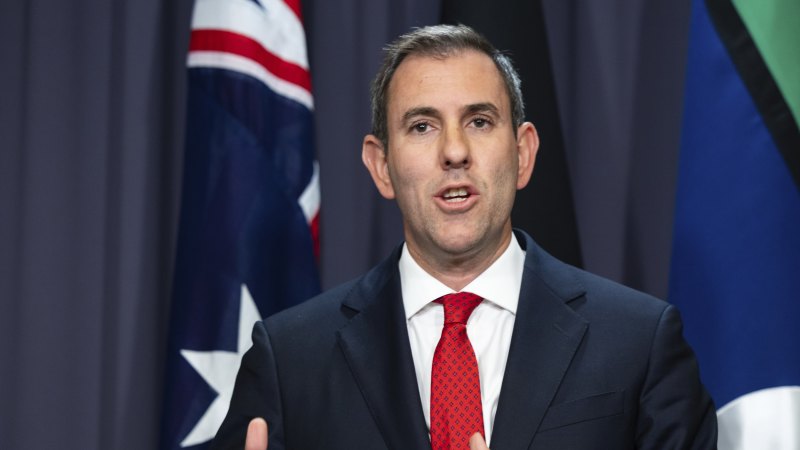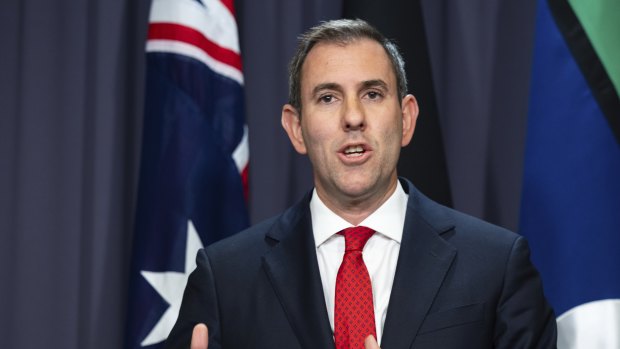Save articles for later
Add articles to your saved list and come back to them any time.
Treasurer Jim Chalmers has told Australians the country faces a choice between complacency and success, releasing an intergenerational report that warns of major challenges to the climate, the economy and the budget over the next 40 years.
The report shows the population will rapidly age, requiring even greater spending on health, aged care and the National Disability Insurance Scheme, putting huge pressure on a federal budget that will sink back into the red and rely heavily on a diminishing pool of workers for income tax.
Treasurer Jim Chalmers says the country faces a choice between success and complacency this decade.Credit: Alex Ellinghausen
The nation’s median age, which climbed by 8.3 years to 38.5 years in the four decades to 2022-23, is expected to grow another 4.6 years to 43.1 years in 2062-63.
Intergenerational reports, first started by then treasurer in Peter Costello in 2002, aim to show the impact of population growth, workforce participation and productivity growth on the nation’s finances and society over the coming four decades.
Chalmers, in an address to the National Press Club, said the report set out the choices the country had to make if it were to fail or succeed in the years ahead.
“We can own the future but only if we take the big shifts seriously,” he said.
“Because if the 1980s meant the end of certainty the 2020s must mark the end of complacency.”
Despite expecting to report a budget surplus of between $21 billion and $22 billion in the just completed financial year, the report forecasts ongoing deficits all the way out to 2062-63.
One of the reasons for the deficits is increased spending on a range of services.
Government spending per person on the NDIS is expected to climb by 237 per cent between now and 2062-63, from $855 to $2879. Spending per person on aged care is tipped to jump by 224 per cent, from $1076 to $3481.
The single largest expense will be on health, up by 117 per cent, to $8677 per person by the early 2060s. Defence will also eat up more of our taxes, climbing 74 per cent to $3263 per person.
But spending on education will flat line as our ageing population means fewer children who need schooling.
By 2062-63, total spending – including on the nation’s interest bill – is forecast to climb from $23,808 per person to $40,162.
As our spending demands increase, the tax system will face substantial challenges.
‘Governments will need to make choices about the structure of the tax system to adapt in the face of this evolving landscape.’
The report notes the tax system will be buffeted by new technologies, decarbonisation, changing consumer spending patterns and an evolving geopolitical outlook that will all re-shape the economy.
The fuel excise, for instance, will effectively disappear as petrol and diesel-powered vehicles are replaced by EVs.
“Governments will need to make choices about the structure of the tax system to adapt in the face of this evolving landscape in order to pay for essential public services,” it found.
It notes that without change to the tax mix, personal income tax will account for 58.4 per cent of all tax collected by the Commonwealth, up from 50.5 per cent now. The share of company tax will fall to 18 per cent of the nation’s tax take, from its current level of 23.5 per cent.
The increased share of income tax will come from a diminishing number of workers.
The “old age dependency ratio”, a measure of the number of people aged over 65 for every 100 people of traditional working age, is expected to jump from 26.6 today to 38.2 in 2062-63.
As the population ages, more people will need health and aged care support paid for by those of working age. At present, just 12 per cent of people over the age of 70, who make up 12.2 per cent of the total population, pay income tax. This group will account for 18.1 per cent of the total population by 2062-63.
The report shows Australia’s population is expected to grow in line with forecasts produced in the 2021 intergenerational report. It expects the population to reach 40.5 million, from its current 26.3 million, by the early 2060s.
Australia’s population is expected to reach 40.5 million by 2062-63, but it will be older and need more health support.Credit: Dan Peled
Those people will be dealing with the fallout from climate change which the report finds could wipe up to $423 billion from economic activity if it is not controlled.
The report shows real national income per person is expected to grow by 50 per cent over the next 40 years, but the rate of increase will be much slower than over the past forty decades. It says this slowdown is due to a drop in key commodity prices, slower population growth, a drop in workforce participation and lower productivity growth.
The report assumes productivity to grow by 1.2 per cent over the coming decades, in line with the average rate of growth of the past 20 years. Previous reports used much higher productivity assumptions.
Cut through the noise of federal politics with news, views and expert analysis from Jacqueline Maley. Subscribers can sign up to our weekly Inside Politics newsletter here.
Most Viewed in Politics
From our partners
Source: Read Full Article



